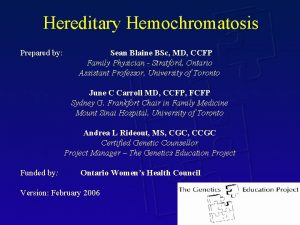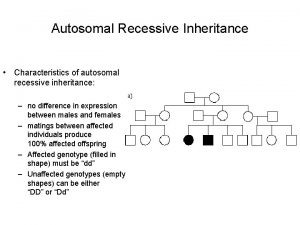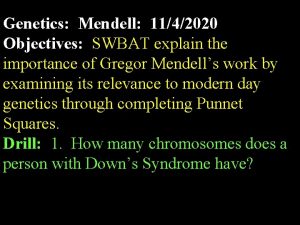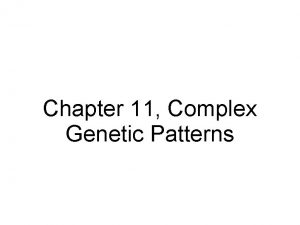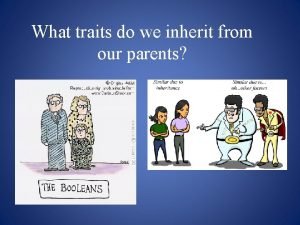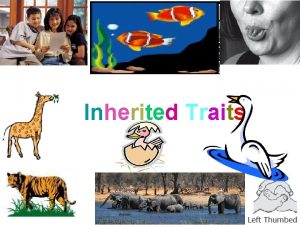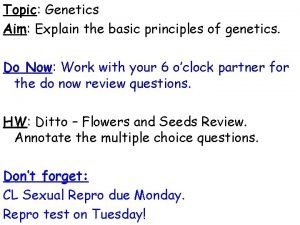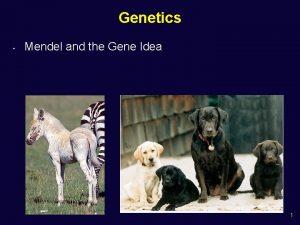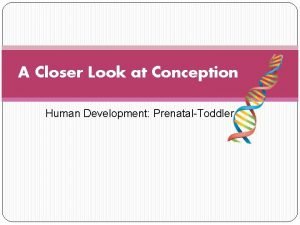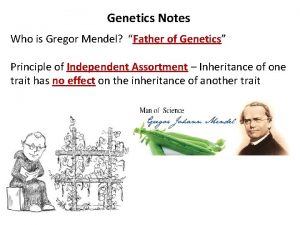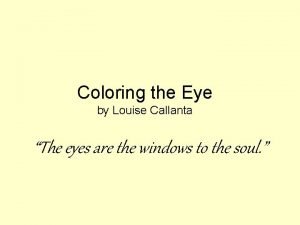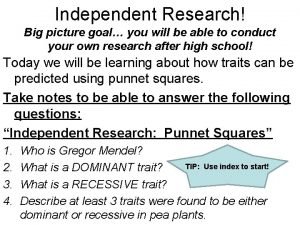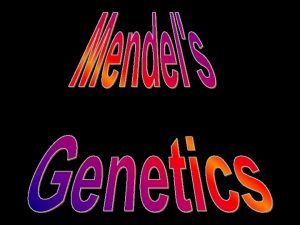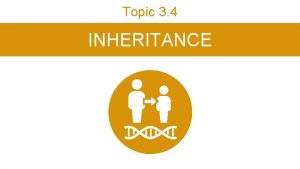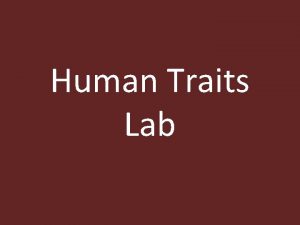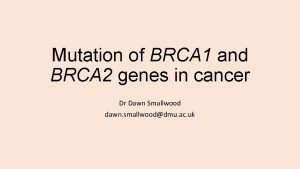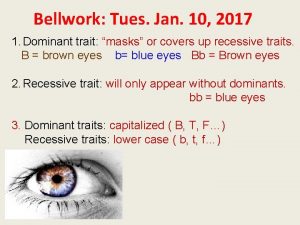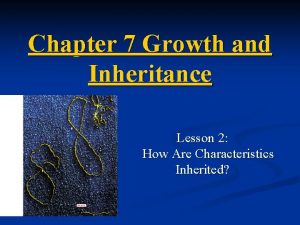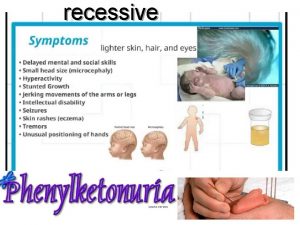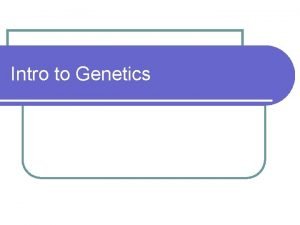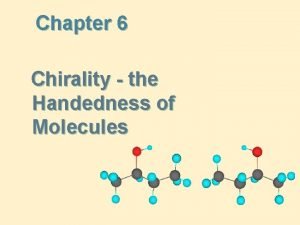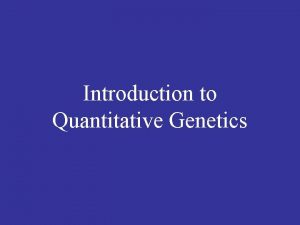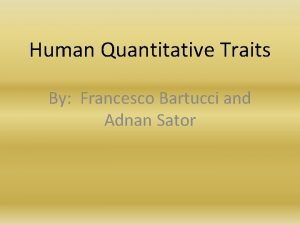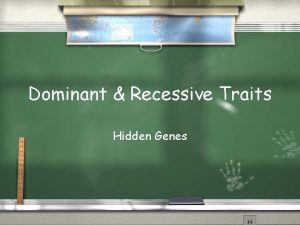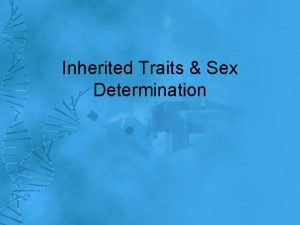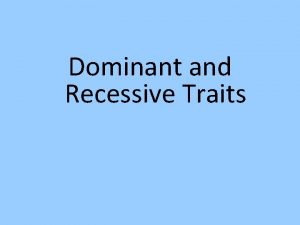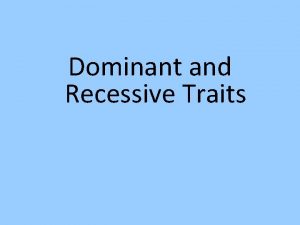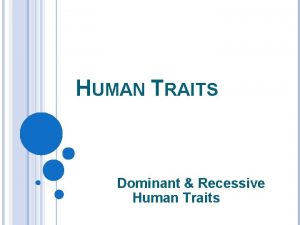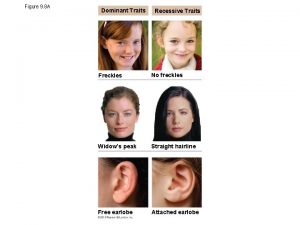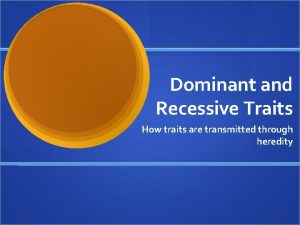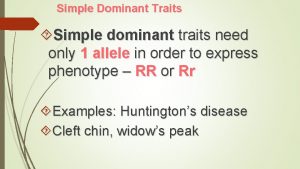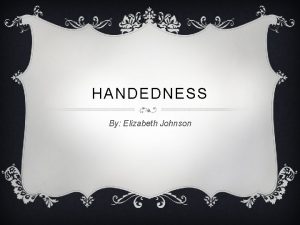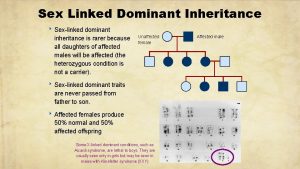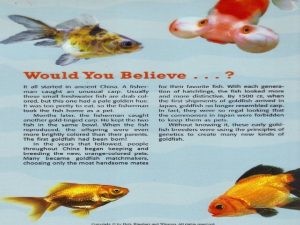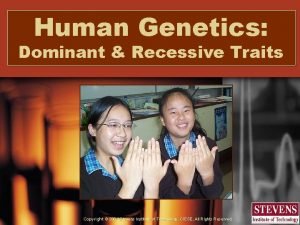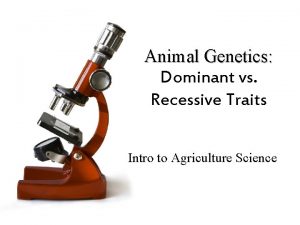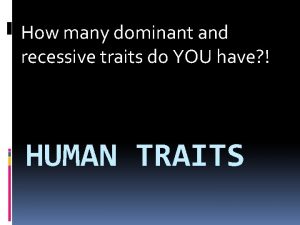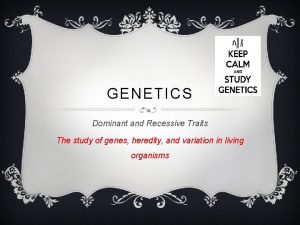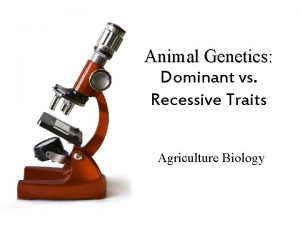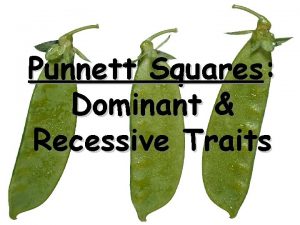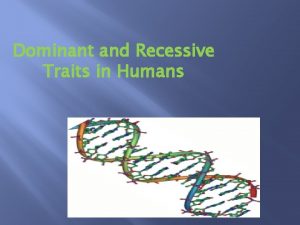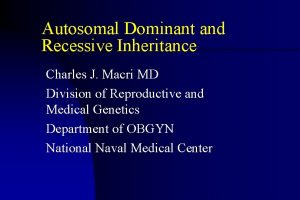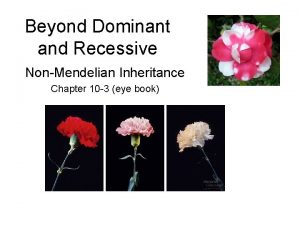Inheritance Selected Hereditary Traits Dominant Recessive Right handedness









































- Slides: 41

Inheritance

Selected Hereditary Traits Dominant Recessive Right handedness Left handedness Hair on middle Segment of digits no hair Hitch-hiker’s thumb Normal thumb Polydactylism (extra digits) Normal digits Brachydactylism (short digits) Normal digits Pattern baldness Normal hair Free ear lobes Attached ear lobes Hitch-hiker’s thumb Free ear lobe Polydactylism is a dominant trait; a normal number of digits is the recessive condition. Attached ear lobe Mid-digit hair Handedness In this crowd of men, almost all show some degree of pattern baldness, a dominant trait.

Eye Color Determination of eye color is complex, involving perhaps many genes. Any eye color other than pure blue is determined by a dominant allele that codes for the production of the pigment called melanin. Hazel, green, grey and brown eyes are dominant over blue. Dominant Recessive Phenotype: Brown, green, hazel, or grey Phenotype: Blue Allele: B Allele: b

Human Handedness The trait of left or right handedness is genetically determined. Right-handed people have the dominant allele. People that consider themselves ambidextrous can assume they have the dominant allele for this trait. Dominant Recessive Phenotype: Right-handed Phenotype: Left-handed Allele: R Allele: r

Human Tongue Roll The ability to roll the tongue into a U-shape when viewed from the front is controlled by a dominant allele. There are rare instances where a person can roll it in the opposite direction (to form an nshape). Dominant Phenotype: Can roll tongue Allele: T Recessive Phenotype : Cannot roll tongue Allele: t

Human Mid-Digit Hair Some people have a dominant allele that causes hair to grow on the middle segment of their fingers. It may not be present on all fingers, and in some cases may be very fine and hard to see. Dominant Recessive Phenotype: Hair on mid segment Phenotype: No hair on mid segment Allele: M Allele: m

Thumb Hyperextension There is a gene that controls the trait known as hitchhiker's thumb, which is technically termed distal hyperextensibility. People with the dominant phenotype are able to curve their thumb backwards without assistance, so that it forms an arc shape. Dominant Recessive Phenotype : Hitchhikers thumb Phenotype : Normal thumb Allele: H Allele: h

Human Ear Lobe Attachment In people with only the recessive allele (homozygous recessive), ear lobes are attached to the side of the face. The presence of a dominant allele causes the ear lobe to hang freely. Dominant Recessive Phenotype: Lobes free Phenotype: Lobes attached Allele: F Allele: f

Important Point • Dominance does not necessarily mean more common in a population • It simply means when it is combined with a recessive allele, that it will be expressed • Consider polydactyly in humans (often related to lethal characteristics)

Mendelian genetics • • • Dominance Recessiveness Monohybrid crosses Dihybrid crosses Polyhybrid crosses

Definitions • • Allele: alternate form of a gene Phenotype: the expression of the gene Genotype: the alleles present in an individual F 1 – first generation (first filial) following the parental generation

Mendel’s Principles • 1. Principle of Dominance: One allele masked another, one allele was dominant over the other in the F 1 generation. • 2. Principle of Segregation: When gametes are formed, the pairs of hereditary factors (genes) become separated, so that each sex cell (egg/sperm) receives only one kind of gene.

• 3. Principle of Independent Assortment: “Members of one gene pair segregate independently from other gene pairs during gamete formation” Genes get shuffled – these many combinations are one of the advantages of sexual reproduction

1. Dominance • Dominant alleles cancel or mask the effect of other alleles for the same characteristic • Normally shown as a capital letter

2. Recessiveness • Recessive alleles are masked by the effect of dominant alleles. They only show when there are two recessive alleles present • Normally shown as a lower-case letter • Eg Brown hair B (dominant) • Blond hair b (recessive)

Punnett Squares • Are a two-way table (probability)

Zygousity • Homozygous – BB (homozygous dominant) – bb (homozygous recessive) • Heterozygous – Bb

Monohybrid crosses • A monohybrid cross occurs when each characteristic is inherited independently. • There is no connection between traits • Calculated as Bb x Bb or BB x bb etc

Dihybrid & polyhybrid crosses • Dihybrid & polyhybrid crosses occur when we are looking at two or more traits of interest. • There may be a relationship between the traits

Non Mendelian Genetics • • • Incomplete dominance Codominance Multiple alleles Sex-linked inheritance Lethal alleles

Non-Mendelian Genetics • Some traits don’t follow the simple dominant/recessive rules that Mendel first applied to genetics. • Traits can be controlled by more than one gene. • Some alleles are neither dominant nor recessive.

1. Incomplete Dominance • • In cases of incomplete dominance, neither allele dominates and the heterozygote is intermediate in phenotype between the two homozygotes. In crosses involving incomplete dominance, the genotype and phenotype ratios are identical. Examples of incomplete dominance include flower color in snapdragons (right) and sweet peas, where red and white flowered plants cross to produce pink flowered plants. Cw Cw C RC R

2. Codominance • In cases of codominance, both alleles are independently and equally expressed in the heterozygote. Examples include: Roan (stippled red and white) coat color in cattle. A cross between a red bull and a white cow produces all roan offspring. ABO human blood groups Red bull . Parents White cow CWCW CRCR X Gametes CR CR CW CW Possible fertilizations CRCW Roan F 1 offspring

Multiple Alleles • More than two alleles for a trait • Example ABO blood typing

Sex Linkage • Is the phenotypic expression of an allele that is dependent on the sex of the individual • is directly tied to the sex chromosomes. • Most sex linked genes are present on the X chromosome (X-linkage) and have no corresponding allele on the smaller male chromosome. In some cases, a phenotypic trait is determined by an allele on the Y chromosome. Because the Y chromosome is small and does not contain many genes, few traits are Ylinked and Y-linked diseases are rare. X Y Note the size differences between the X and Y chromosomes. The Y lacks alleles for many of the genes present on the X.

Sex Linkage • Unaffected father Sex-linked traits show a distinct pattern of inheritance. Fathers pass sex-linked alleles to all their daughters but not to their sons. X Carrier mother Y X X Mothers can pass sex-linked alleles to both sons and daughters. In females, sex-linked recessive traits will be expressed only in the homozygous condition. XY XX XX XY In contrast, any male receiving the recessive allele from his mother will express the trait. Unaffecte d son Unaffecte d Carrier daughter Affected son

• Sex Linked Recessive Inheritance For a recessive trait controlled by a gene on the X chromosome, the features of inheritance can be illustrated with the standard symbols used on pedigree charts. Unaffected female Affected male Carrier More males than females express the trait. Carrier females do not show the trait but pass it to sons. All daughters of affected males will at least be carriers of the trait. Famously, Queen Victoria was a carrier of the allele for hemophilia, passing it to one of her sons and, through her daughters, to the royal families of Prussia, Russia, and Spain.

Lethal Alleles • Lethal alleles are gene mutations that result in a gene product which is not only non-functional, but affects organism survival. • Some lethal alleles are fully dominant and are therefore lethal in the heterozygote. • Dominant lethal alleles are usually eliminated rapidly, because their expression is fatal. Exceptions occur when the expression of the allele is delayed until after reproductive maturity, as occurs in Huntington disease. • In other cases (e. g. Manx cats), the allele mutation results in a viable heterozygote with a recognizable phenotype. • Recessive lethal alleles are fatal only in the homozygote since their effect is masked in the heterozygote carrier.

Examples of Lethal Alleles • • When lethal genes prevent full term development of the embryo, offspring are produced in a 2: 1 ratio (2 heterozygotes to one normal). In the inheritance of coat color in yellow mice, offspring phenotype ratios depart from the expected Mendelian 3: 1 when yellow mice are mated together. About two thirds of the offspring are yellow, and one third are non-yellow (right). A testcross reveals the yellow colored mice to be heterozygotes. Parents X Yy Gametes Y Yy Y y y Possible fertilizations YY Not viable Yr Yr Offspring yy

• • Incidence of Lethal Alleles The average human is heterozygous for 3 to 5 lethal recessive genes. Example: brachydactyly in humans Shortening of the finger bones is caused by a lethal allele; heterozygotes have shorter fingers, but homozygotes for the lethal allele die in infancy from other skeletal defects. Of the offspring of two brachydactylic people, one in four will die in infancy, one half will show brachydactyly, and one in four will be normal (1: 2: 1 ratio). X-ray of a normal hand Brachydactyly: note the shortened bones

Pedigrees

What is a Pedigree?

A Pedigree is a Family Tree. In genetics it is a record of genetic information within a number of generations of an organism. For example: a pedigree would show the inheritance of a trait such as Blue eyes or Haemophilia in a family.

- pedigrees allow the tracking of a certain character/s over generations of related individuals. - it can be used to predict the likelyhood of of offspring inheriting specific characteristics, such as haemophilia and colour-blindness

• There is a standard set of pedigree symbols used to denote the phenotype of individuals in a family.

The Royal Family & Haemophilia

In this instance, haemophilia is: - X – linked recessive - so there is a much higher chance of the males in this family suffering haemophilia than the females because: - if the carrier (mother) is heterozygous (recessive) then the male offspring has a: - 50/50 chance of receiving the recessive allele.

Whereas the female offspring would need both: - a haemophiliac father and: either a carrier or haemophiliac (homozygous recessive) mother in order to contract the condition.

Colour - blindness

Your Family Pedigree Now construct a pedigree for your family, pick a trait (such as Blue eyes) or make one up and construct a family tree for four generations. Remember: • Normal Males are drawn with a • Affected Males with a coloured • Normal Females are drawn with a • Affected Females with a coloured

• • Carrier Males with Carrier Females with Partners and siblings with horizontal lines Offspring with vertical lines
 Right product right place right time right price
Right product right place right time right price Family time
Family time Hereditary hemochromatosis inheritance pattern
Hereditary hemochromatosis inheritance pattern X linked dominant pedigree
X linked dominant pedigree Autosomal recessive
Autosomal recessive Genetic square
Genetic square Is down syndrome dominant or recessive
Is down syndrome dominant or recessive Is a widow's peak dominant
Is a widow's peak dominant Dominant vs recessive genetic disorders
Dominant vs recessive genetic disorders Are dimples recessive
Are dimples recessive Heterozygous for type a blood
Heterozygous for type a blood Vulcan hand sign dominant or recessive
Vulcan hand sign dominant or recessive Dominant and recessive genes
Dominant and recessive genes Colorblind punnett square
Colorblind punnett square Blue eyes dominant or recessive
Blue eyes dominant or recessive Mendelian law of inheritance
Mendelian law of inheritance Phynelketonuria
Phynelketonuria Dominant and recessive genes
Dominant and recessive genes X linked dominant pedigree
X linked dominant pedigree Is hitchhiker's thumb dominant or recessive
Is hitchhiker's thumb dominant or recessive Two parents with green eyes
Two parents with green eyes Are dimples dominant or recessive
Are dimples dominant or recessive Blood type punnet square
Blood type punnet square Punnet square
Punnet square Hemizygous
Hemizygous Earlobe
Earlobe Dimples dominant or recessive
Dimples dominant or recessive Is brca dominant or recessive
Is brca dominant or recessive Are thin lips dominant or recessive
Are thin lips dominant or recessive Unattached earlobes
Unattached earlobes Pku dominant or recessive
Pku dominant or recessive Free earlobes dominant or recessive
Free earlobes dominant or recessive Phenotype
Phenotype Polyhydroxy aldehyde
Polyhydroxy aldehyde R and s enantiomers
R and s enantiomers X linked dominant inheritance punnett square
X linked dominant inheritance punnett square Incomolete dominance
Incomolete dominance The right man on the right place at the right time
The right man on the right place at the right time Inheritance of quantitative traits
Inheritance of quantitative traits Dominant genetic variance
Dominant genetic variance Inheritance of quantitative traits
Inheritance of quantitative traits Qualitative traits vs quantitative traits
Qualitative traits vs quantitative traits


